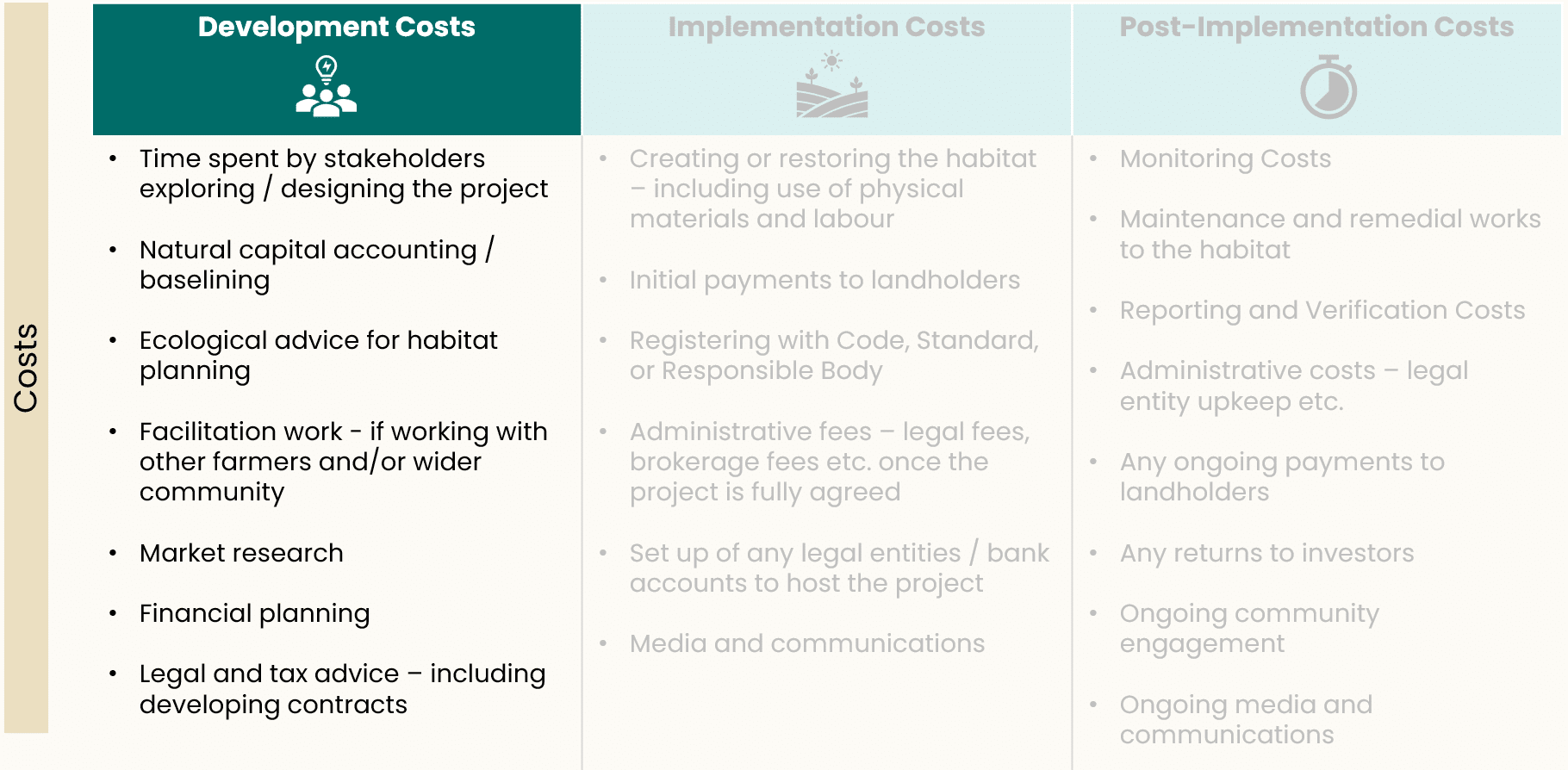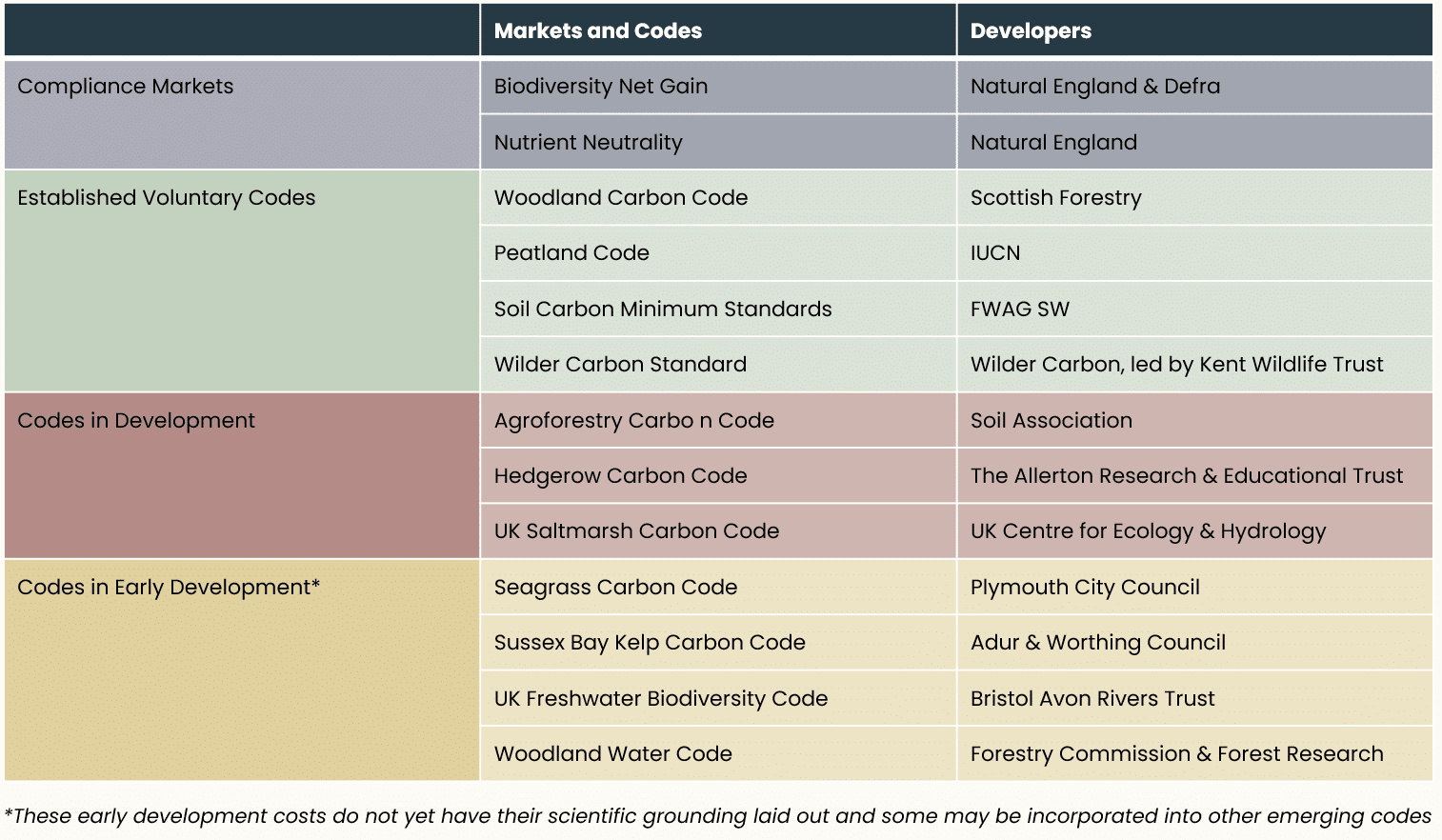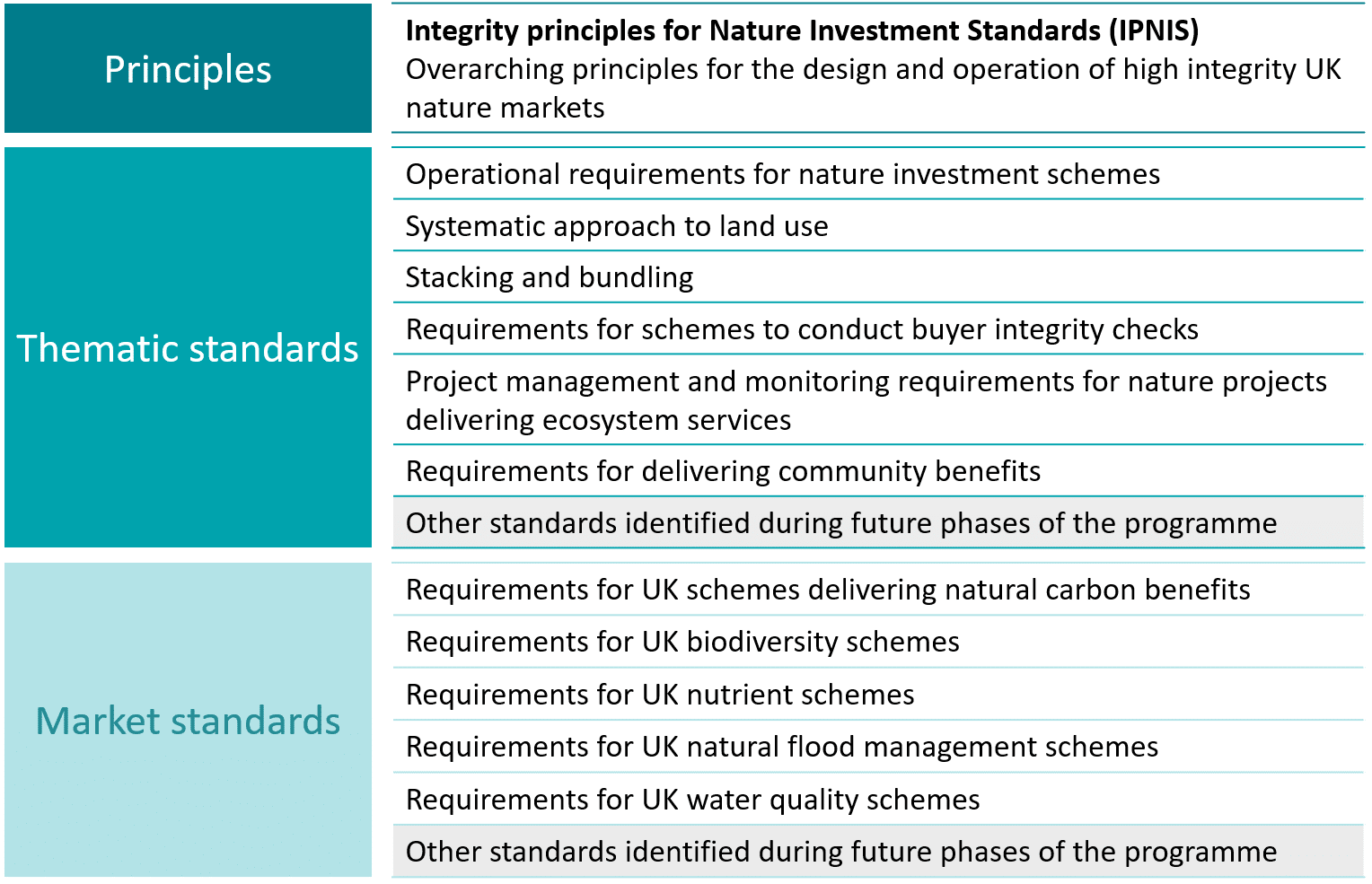- Groundwork
- Market Engagement
- Groundwork
- Market Engagement
How do public sector funding and policy align with nature markets?
In England, the role of public funding and support to farmers is undergoing change on a scale not seen in decades. The government hopes to strengthen the link between environmental and farming practices to meet its climate and nature restoration targets, while maintaining food security and the viability of farm businesses across the country.
This section offers a summary of how government is working with farmers to access nature markets, and provides guidance on:
- How nature markets might work with public subsidy schemes,
- What development funding is available for farmers to explore their opportunities,
- What ‘market infrastructure’ the government is supporting – including Standards and Codes.
This milestone contains three subsets of considerations or ‘themes’ that farmers may want to explore at this stage. Click on each of these themes to the right in order to read more.
Government Schemes
Today, farmers face a degree of uncertainty as to what their public funding choices will be in the future, due to the phasing out of Basic Payment Scheme (BPS) by 2024 – to be replaced by Delinked Payments until 2027 – and the introduction of the Environmental Land Management schemes (ELMs).
On top of this, farmers are often invited to participate in nature markets, but are concerned that any offers – no matter how lucrative now – will exclude them from more advantageous public funding in the future. This is a legitimate concern, and one that the government is trying to address with further rules and clarity to be provided.
The Government has stated its desire for ELMs to work alongside nature markets and private sector finance, as set out in the ELMs Payment Principles.
Below offers a brief description of the most common public grants and offers that are tied to environmental practices, along with what has been stated so far as to their blendability with nature markets.
| ELMs | Overview | Activities | Dates and grant values | ‘Blendability’ with Nature Markets |
| Sustainable Farming Incentive | Sustainable Farming Incentive (SFI) is a new scheme that is designed for mass uptake. If you were eligible for the Basic Payment Scheme (BPS) in 2022 or 2023, you’ll be able to apply for the SFI.
SFI is a 3-year agreement made up of a choice of environmental land management actions you need to complete to receive payment.
SFI was designed around actions that can be take alongside general farming practices.
|
You can apply for up to 23 actions for:
The number of actions will expand each year until the full range is available by 2024. |
Open date:
Farmers are now able to apply.
Closing date: to be confirmed.
Grant value: between £10 and £798 per hectare, depending on the action. In 2024, we are taking a significant step forward to achieve that. We are: In the Agricultural Transition Plan 2024 update, the government has stated its intention to increase payment rates by an average of 10% for SFI and CS. |
Defra has confirmed that Sustainable Farming Incentive (SFI) applicants may enter the same area of land into an SFI standards agreement and a private sector scheme arrangement, such as carbon trading or payments for natural flood management, subject to any eligibility rules or additionality tests applied by the private sector scheme in question.
This approach will be reviewed annually. |
| ELMs | Overview | Activities | Dates and grant values | ‘Blendability’ with Nature Markets |
| Countryside Stewardship | Countryside Stewardship (CS) is a pre-existing scheme that offers a wider range of options for farmers in terms of eligible activities and length of agreements. It has three main tiers:
Note: previously Defra had planned to replace the CS scheme with the Local Nature Recovery Scheme. However, in early 2023 it decided instead to amend the existing CS scheme, due to a higher-than-expected uptake. |
There are c.250 CS grants with different actions attached.
You can use the CS Grant Finder to find specific actions that are eligible. You can also browse the grant finder for actions that generally improve: Defra will also add 30 additional actions to the 250 actions already available to farmers by the end of 2024. |
Closing date: some grants are open all year, others are time-limited. Please refer to the CS guidance and individual CS grants for more detail.
In the Agricultural Transition Plan 2024 update, the government has stated its intention to increase payment rates by an average of 10% for CS and SFI. |
Defra intends for CS to dovetail with private schemes and markets for high-quality, accredited environmental outcomes, ensuring that private finance is crowded in. Further guidance on specific schemes is pending. |
| ELMs | Overview | Activities | Dates and grant values | ‘Blendability’ with Nature Markets |
| Landscape Recovery
(Pilot) |
Landscape Recovery (LR) will pay groups of farmers and land managers to co-design bespoke projects and agreements to produce environmental and climate goods across landscape scale projects.
Land must be in England and consist of at least 500 connected hectares.
The LR scheme is currently in pilot, with grants offered to c.50 farmers groups to help develop the scheme. So far, two rounds have been run and a third round is expected in 2024. |
You can apply to join the Landscape Recovery scheme if you’re planning to do a landscape-scale project that supports:
The scheme will support outcomes that take a long time to deliver, such as peatland restoration, woodland management, or habitat restoration. |
The LR scheme is expected to be rolled out for wider implementation in 2024.
LR projects will be selected in rounds, which will involve a competitive application process.
Defra have committed to launching a further round in 2024 and expect to continue to launch at least two annual rounds in future years as the LR scheme is scaled up.
Estimates of grant values have not yet been released. |
Defra is keen to make the LR scheme ‘blendable’ with nature markets, and has made it a requirement of pilots across both rounds to explore this factor in their work.
Projects will be supported to develop credible proposals for attracting private finance, for example they will be able to use the LR grant to help them develop land management plans and create business models. |
The England Woodland Creation Offer (EWCO) supports the establishment of new woodlands and is administered by the Forestry Commission.
EWCO has laid out a clear set of rules for combining payments for woodland creation with payments from nature markets. It offers a core grant for woodland creation, and landowners receiving this are eligible to register with the UK Woodland Carbon Code (subject to Code’s rules and requirements) to use carbon finance as well.
It also offers ‘additional contributions’, which are one-off payments to allow new woodlands to be designed to deliver additional benefits, including water quality and biodiversity. Recipients of an ‘additional contribution’ are not currently allowed to also sell these benefits as ecosystem service units in the market, as this would be considered double counting. In future Defra will allow the contributions to be repaid so that a woodland developer can instead sell water and biodiversity credits on the market if they wish to do so.
Note: EWCO will become part of the Countryside Stewardship scheme from 2025.
Farmers are encouraged to keep up to date with these schemes and research other grants available – such as through the government’s grant browser, to explore further grants that could be used alongside nature market trades.
Development Funding
It can take significant resources to develop an environmental improvement scheme before it gets to a point where it can generate any revenue or attract grants. These resources are often referred to as development costs.
While it is not always easy to decide if something is a development cost, it may be useful to think about this difference in the diagram below:
Depending on the project, some development costs can be covered by:
- Special ecological grants – such as the Woodland Creation Planning Grant
- Advance payments from buyers
- Repayable finance – such as private equity offered by an angel investor
- Funding from third party project developers – likely taking a larger share of the later income
- Use of own funds – some farmers have invested their own savings into these projects
However, these options may not always be feasible. In this case, development grants can be a highly useful source of funding for farmers. Development grants are usually provided by government or philanthropic sources, and are non-repayable.
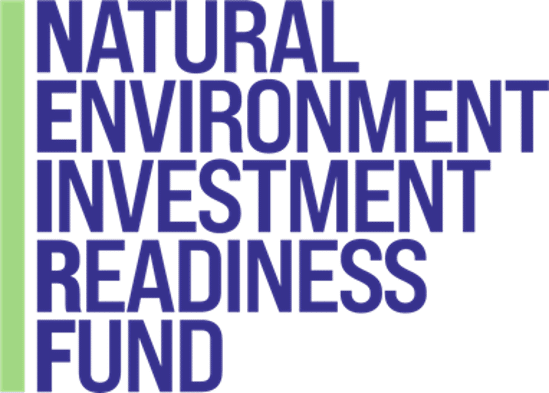
The Natural Environment Investment Readiness Fund (NEIRF) is a development fund for projects that have the potential to produce revenue from the benefits nature provides, as well as projects able to produce an investment model that can be scaled up and reproduced. It is ran by Defra and the Environment Agency.
So far, grants of up to £100,000 have been given to 86 projects across two rounds – including environmental NGOs, local authorities, businesses, estate managers and farmers. These projects are targeting a wide range of environmental outcomes aligned to the 25 Year Environmental Plan – including improved soil health, water quality, and biodiversity uplift.
A third round for farmers is now open
On 11 December 2023, a third round of NEIRF was opened specifically for farmers. The NEIRF is offering individual grants of up to £100,000 to farmers that want to explore nature markets and other ways of leveraging private finance for nature. The goal is to develop replicable and scalable blueprints and business models that other farmers can use.
You can find more detail and the application form here. Applications close on the 16th of February 2024.
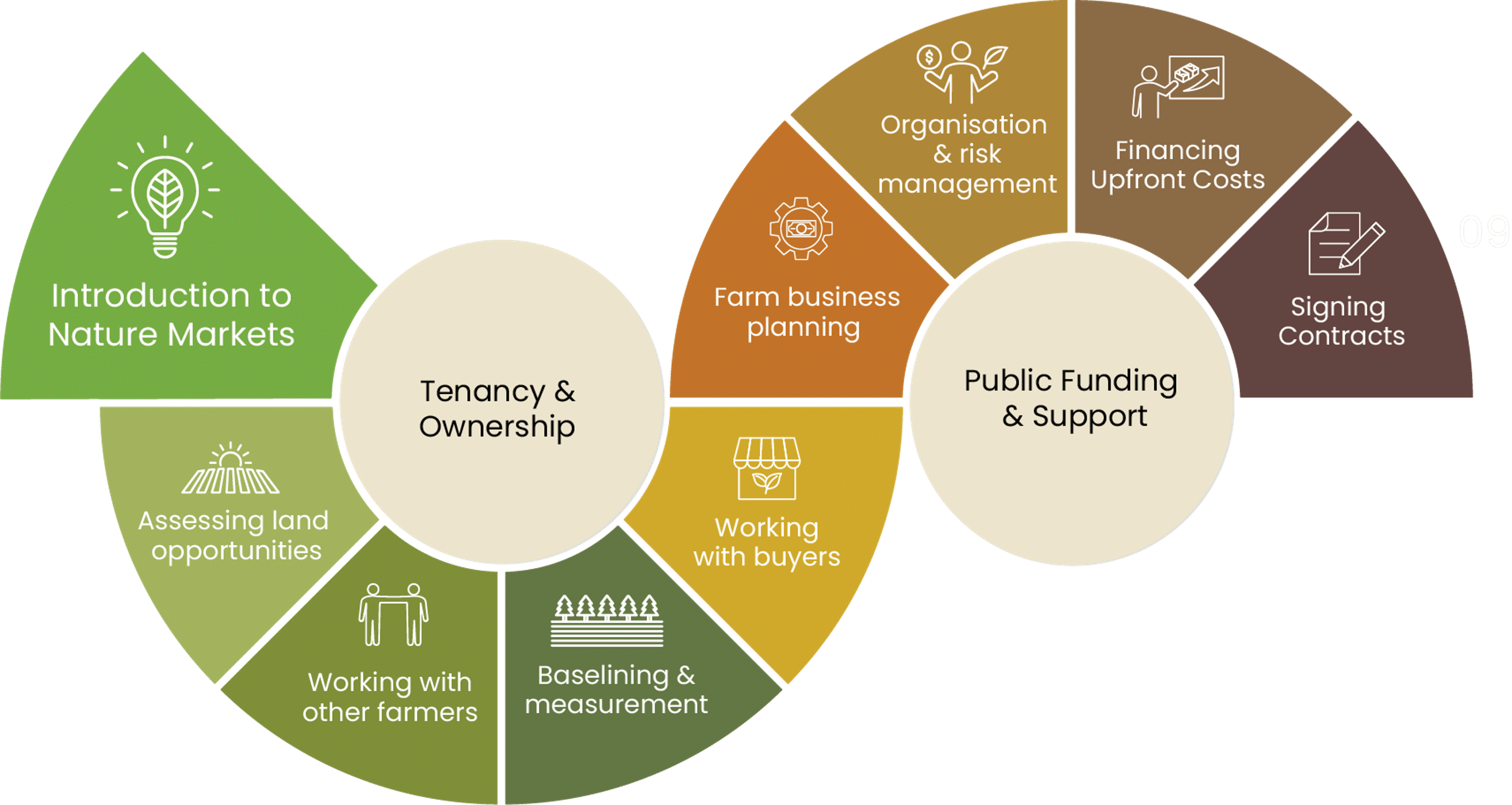
The GFI has been working closely with Defra and the Environment Agency to design this Farming Toolkit as an integral resource in NEIRF Round 3. It will be used to:
- Help with the assessment of applications
- Guide the monitoring and evaluation of the NEIRF Round 3
- Support the Community of Practice – providing a common framework of understanding so that farmers can learn from each other more effectively.
As a result, we would encourage farmers that are interested in applying to NEIRF Round 3 to familiarise themselves with the Toolkit and consider how they might develop their projects via the Milestones. This approach is not compulsory, but may help with the development of your application.
While the NEIRF Round 3 is a bespoke development fund that is aimed at farmers wanting to explore their nature market opportunities, other sources of funding may be available that cover some of your development costs.
For example, if your project involves restoring a particular type of habitat or has a strong community focus, then other funding may be available for these specific activities. We would encourage farmers to search for funding that can cover some or all of their development costs.
Government Funding
Below is a brief list of government funding sources that have been known to overlap with farmers exploring their nature market opportunities. These may not be available year round, and we cannot guarantee that your own project will be eligible:
- Countryside Stewardship Facilitation Fund (specifically for farmers working together)
Other Funding
In addition to government support, there are a host of organisations, such as environmental charities, academics, and private companies, that may be willing to help you with certain development costs.
Many of these types of organisations received development funding from Rounds 1 and 2 of NEIRF themselves, and want to work with farmers in the near future to expand their models of delivering environmental outcomes with the use of private finance.
As a farmer, you may wish to start conversations with some of the below organisations, to see what plans they have of working with farmers in the nature markets space:
- Your local Rivers Trust
- Your local Wildlife Trust
- Your regional Farming and Wildlife Advisory Group (FWAG)
- Your local water company – (see here for a useful Farmers Weekly article on the types of schemes that water companies can offer farmers)
Standards and Market Rules
As a farmer exploring your nature market opportunities, you may hear about different Standards and Codes, asking what they entail and how suited they are for your deal.
We’ve included a section on Standards and Codes here because they can play an invaluable role in nature markets – setting rules and processes for buyers and sellers to follow in a way that makes deals more robust.
The UK Government is also supportive of Standards and Codes, and is developing an overarching set of market standards to provide oversight and regulation of the ones currently in development.
Below is a breakdown of the questions you might ask about Standards and Codes, to add further detail to the above.
In the context of nature markets, Standards and Codes provide processes that allow sellers and buyers to make trades with certain assurances and clarity.
For example, they typically set out processes for:
- Measuring the environmental improvement, often building a scientific grounding over several years before becoming operational and offering such processes.
- ‘Unitising’ the improvement to be understood by buyers and other stakeholders – such as with carbon units (tonnes of CO2e) and nitrogen credits (kilograms of nitrogen).
- Selling the improvement to a buyer using processes to increase the integrity of the trade, such enforcing additionality tests, rules around public disclosures, disputes resolutions, and registries to prevent double counting.
- Verifying whether the project plans to deliver, or is delivering the environmental improvement in a robust way and reliable way.
-
- Note: Codes and Standards often work with a third party verifier – such as the Soil Association and Organic Farmers and Growers, to make impartial verifications.
In this Toolkit, we use the words Codes and Standards interchangeably, as do many stakeholders in this space. However, you can find a more technical breakdown of the differences in our Glossary.
In England, there are several Standards and Codes that are either in operation or in development.
Each of these targets a specific habitat type (hedgerows, agroforestry, peatlands) or an environmental improvement that can be delivered from different habitats (Biodiversity Net Gain, Nutrient Neutrality, Wilder Carbon).
The below table summarises these Standards and Codes, including which ones are voluntary or compliance driven, and what organisation leads them:
Support given so far
The Government is highly supportive of the use of Standards and Codes in nature markets, having given both development funding and direct input into several of those in development and in operation.
Notably, the English Government has created compliance markets for Biodiversity Net Gain and Nutrient Neutrality, which make it compulsory for property developers to offset their impacts on biodiversity and nutrient levels in local waterways – with the limited option of purchasing ‘offsite’ environmental improvements from landholders. The metrics and processes that the government uses to do this are not called Standards or Codes, but in practice they work in a similar manner.
In terms of voluntary markets, the UK government was an early supporter of the Woodland Carbon Code and the Peatland Code, and today government agencies like Defra and BEIS sit on the Executive and Advisory Boards of these Codes. Furthermore, eight of the Standards and Codes in the above table also received development funding from the first two rounds of NEIRF, which is run by Defra and the Environment Agency.
The organisations that lead these voluntary Standards and Codes are not government-based. More commonly they are environmental charities and academic organisations. The government is broadly comfortable with this approach, but it also recognises the need for an overarching framework to regulate the Standards and Codes that are brought to market.
Plans to further support Standards and Codes – Nature Investment Standards Programme
Defra recognises that the current lack of Standards and Codes is holding back investment and market development, particularly for environmental improvements and land use/habitat types where methodologies for measuring these are new – such as hedgerow carbon sequestration.

.
Below is a list of what the Programme aims to deliver:
Source: BSI Nature Investment Standards Programme, 2023
The Integrity Principles were published in July 2023. The first set of standards from this Programme is expected to be made available in 2024.
If you are interested in feeding into this work – you can learn more about the programme and sign up to get involved here.
As one parcel of land can produce many valuable ecosystem services, farmers and other market stakeholders often ask whether it’s possible to recognise these different services in a nature market deal and earn more income. Conceptually, this can be done by either stacking or bundling the ecosystem services.
In the Nature Markets Framework, published March 2023 by Defra, the following definitions are set out:
- Bundling: When a suite of ecosystem services produced by the same activity (for example the biodiversity and water quality improvement provided by wetland restoration) is sold as a single combined unit in the market.
- Stacking: When multiple different ecosystem services produced by the same activities (for example biodiversity and carbon benefits of a new woodland) are sold as separate units in the market.
While bundling is relatively easier to achieve, the rules of stacking are largely unclarified, due to complications around concepts like additionality. If you’re hoping to earn extra income from land that you’re committing to a nature market deal, it’s important to check with both sources of income that this is acceptable to do.
Stacking Rules in Different Markets
The below rulings have been set out by the responsible bodies and summarised in the Nature Markets Framework.
- Biodiversity Net Gain (BNG) and Nutrient Mitigation
Phase 1 guidance permits units to be issued for both BNG and nutrients from the same activity/project. They do not permit units to be issued for BNG or nutrients and also for a voluntary ecosystem market from the same activity/project, unless through a subsequent habitat improvement. This improvement needs to be quantified in comparison to a baseline which includes the initial activity.
- UK Woodland Carbon Code
The WCC states that currently the wider benefits of woodland creation projects are ‘bundled’ with the carbon unit by default when they are sold. In future, the WCC Secretariat may agree additional ecosystem service standards that can be stacked with the WCC. Once agreed and the necessary registry infrastructure is in place to keep track of ‘stacked’ and ‘bundled’ projects, woodland creation projects should be able to stack these standards with WCC provided that all income streams are declared in the WCC Cashflow Spreadsheet and the project meets required additionality tests. The potential to credit water or biodiversity and stack with carbon credits is being investigated.
- UK Peatland Code
As with the UK Woodland Carbon Code, the Peatland Code’s guidance states clearly that units are currently sold as an implicit bundle in which other ecosystem services associated with peatland restoration (such as biodiversity and water-related benefits) are ‘bundled’ in with the measured carbon unit. The UK Peatland Code notes that in future it may be possible to stack multiple voluntary credits where these meet the additionality criteria of the Code, and again provided the right registry infrastructure is in place to prevent double counting, and is exploring how this could be done.
